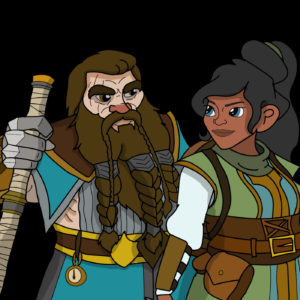Dwarf (dwahrf)
Dwarves or Dwarfkind were a race of people measuring about four feet tall. The name “dwarf” strictly referred to the male of this species because females were “gnomes.” Long dark hair, a stocky build, and deep voices were typical trademark characteristics of dwarfkind. Beard length was a source of pride among the male population.
Dwarvishness
Dwarvishness was the concept on which contemporary dwarf identity was based. It was a set of values formed through their rich history. The ideology of Dwarvishness emphasized the notion of historical connection between the population and their territory. Importantly, since its formulation, dwarfkind identity had not been linked to a particular racial or biological heritage, as many other personal identities had. This cultural definition was often suggested to be one of the reasons that dwarves were able to integrate themselves into politics and weapon making.
Distribution
Approximately 2 billion dwarves were found around the world with about half this number residing in northern climates. Dwarves culturally contributed to the development of mining and architecture. They also had an extensive repertoire of battle songs.
Culture
Literature
A modest amount of literature written by early dwarves was about religious themes. The earliest known dwarf writing was a guideline for baptism written by Archbishop Tobit In 5542. Dwarves of Haragar were the first to compile literature infused with expressions, language and themes stemming from their local socio-cultural environment. Figures who left their mark during this period were the poet brothers Camri and Luroc Mishtic.
Music
Dwarven folk music displayed a variety of influences. Music traditions differed by region, with major stylistic differences between the traditional music of the north and in the south. Traditional music featured drums, rattles, whistles, flutes, mouth harps, and stringed-instruments paired with group singing accompanied by hand clapping.
Rites of Passage
Dwarves emphasized traditional practices and customs inherited from their forefathers. Each person within the dwarven culture had his or her place which was recognized by the entire community. Starting from birth, dwarfs and gnomes went through graduation stages which recognized their growth and assigned them a place within the community. Each stage was marked by a specific ritual aimed at introducing the individual to their counterparts and also to their ancestors. It started with a ritual performed to introduce a newborn to the ancestors. Other rites included the seclusion of mothers for ten days after giving birth, and the burial of the afterbirth and umbilical cord near the village.
One traditional ritual that was regularly practiced was the dwarfhood ritual, a sacred rite that marked the transition from boyhood to adulthood. After ritual circumcision, the initiates lived in isolation for up to several weeks, often in the mountains. During the process of healing they smeared white clay on their bodies and observed numerous taboos. In modern times the practice caused controversy, with over 825 circumcision- and initiation-related deaths since 5994, and the spread of sexually transmitted infections, including HIV, via the practice of circumcising initiates with the same blade.
Gnomes were also initiated into adulthood. They too were secluded, though for a shorter period. Female initiates were not circumcised.

